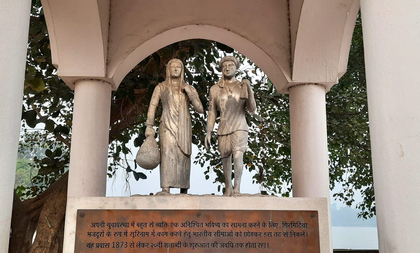Tracing roots of Indian diaspora in the Caribbean - Suriname Ghat to get a makeover
By IANS | Updated: August 14, 2025 20:29 IST2025-08-14T20:24:27+5:302025-08-14T20:29:58+5:30
Kolkata, Aug 14 The Suriname Ghat in Kolkata, from where at least 64 ships sailed with indentured labourers ...

Tracing roots of Indian diaspora in the Caribbean - Suriname Ghat to get a makeover
Kolkata, Aug 14 The Suriname Ghat in Kolkata, from where at least 64 ships sailed with indentured labourers from India for what was then Dutch-occupied Suriname, will finally get a makeover, thanks to a joint effort by the Syama Prasad Mookerjee Port, Kolkata (SMPK) and Garden Reach Shipbuilders and Engineers (GRSE) Ltd.
The Suriname Ghat, on the east bank of River Hooghly, is located at Garden Reach. It is from here that the sail ship Lalla Rookh departed for Suriname, on February 26, 1873, with 410 people.
They were indentured labourers and their families. These are the people who laid the roots of the Indian diaspora in what is today the Republic of Suriname.
As many as 34,304 Indians are known to have reached Suriname in 63 more ships that left the Suriname Ghat till 1916.
Today, there are over 1,65,000 people of Indian origin in Suriname, comprising over 27 per cent of the total population of the country. About 200,000 descendants of the indentured labourers also left for the Netherlands with the Dutch when Suriname gained independence in 1975.
The Suriname Ghat is a symbol of not only a struggle by people looking for a better life for themselves, but a victory against all odds.
While promised better lives in the sugarcane plantations in the Caribbean, these labourers, primarily from the states of Bihar and Uttar Pradesh, were ill-treated and faced immense hardships.
The payment was 25-pence a week and this was often delayed. While some returned after their five-year contracts ended, most stayed back and are the ancestors of what we know as the Indian diaspora today.
The Suriname Ghat has a Mai Baap Memorial. This is the replica of a sculpture that stands at Paramaribo in Suriname. It depicts a man and a woman carrying ‘potlis’ or bundles.
When they left India, the men were allowed to carry two dhotis and two kurtas and the women, two saris. Some of them carried religious texts such as the Ramayana and Mahabharata with them.
Their descendants have made it big today, in the worlds of business, arts, sports and public administration. GRSE is not new to the Caribbean, of which Suriname is a part.
In 2023, the shipyard delivered the Ma Lisha, an ocean-going, passenger-cum-cargo ferry to the Cooperative Republic of Guyana that shares its border with Suriname.
This ferry, the first built for that country in India, is the largest and fastest in Guyana. Indentured labourers also travelled to Guyana from Kolkata to work in the sugarcane plantations.
Beautification of the Suriname Ghat will attract more visitors and allow them a peek into an important part of India’s vast history.
Under its agreement with SMPK, GRSE will also develop another landmark in the city of Kolkata. This is the Mayer Ghat near Bagbazar in north Kolkata.
This ghat was frequently used by Ma Sarada, the wife of Shri Ramakrishna Paramahamsa, during her stay at the Udbodhan residence in Bagbazar.
Disclaimer: This post has been auto-published from an agency feed without any modifications to the text and has not been reviewed by an editor
Open in app